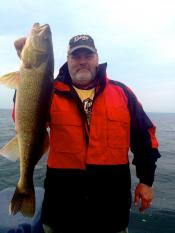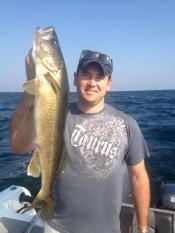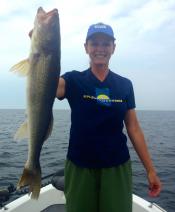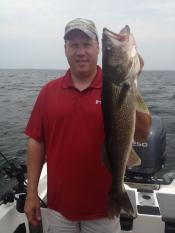 Many traditional rules for catching walleyes don’t apply when you’re targeting suspended walleyes in the open water using crankbaits. An angler needs to think out of the box and keep an open mind while constantly challenge themselves in order to be successful. The suspended walleyes can be anywhere and that’s the beauty of it. If you put your time in and scout, you will eventually find them and then it’s just a matter of time until you figure out what they want and how they want it presented.
Many traditional rules for catching walleyes don’t apply when you’re targeting suspended walleyes in the open water using crankbaits. An angler needs to think out of the box and keep an open mind while constantly challenge themselves in order to be successful. The suspended walleyes can be anywhere and that’s the beauty of it. If you put your time in and scout, you will eventually find them and then it’s just a matter of time until you figure out what they want and how they want it presented.
Over the last couple of weeks, I conducted three open water trolling clinics and fun fished another 3 days. Each day is a little different out there and you need to have an open mind in regard how you go about trying to figure out the pattern. What worked yesterday or in the morning, may not work in the present moment. That’s the very reason I always start out by trying a couple of different crankbait profiles and 4 different colors trolled at different depths.
 Mille Lacs Lake is one of the premier walleye fisheries in the world. It offers some of the best walleye structure an angler can imagine. Even though its over 130,000 acres in size, the lake is relatively shallow and the majority of the lake is only about 35 feet deep. When it comes to classic walleye structure, Mille Lacs has it all – sand, gravel and mud. You can find all kinds of structure within the lake including steep breaklines, humps, reefs, bars and fingers. Many anglers congregate on the famous “mud flats”. I think flats is not the right word to describe them, to me they’re more like mud shelves or mud plateaus that protrude upwards from the bottom of the lake. The reason why anglers fish these areas is because they hold baitfish and that’s why the walleyes are found there as well.
Mille Lacs Lake is one of the premier walleye fisheries in the world. It offers some of the best walleye structure an angler can imagine. Even though its over 130,000 acres in size, the lake is relatively shallow and the majority of the lake is only about 35 feet deep. When it comes to classic walleye structure, Mille Lacs has it all – sand, gravel and mud. You can find all kinds of structure within the lake including steep breaklines, humps, reefs, bars and fingers. Many anglers congregate on the famous “mud flats”. I think flats is not the right word to describe them, to me they’re more like mud shelves or mud plateaus that protrude upwards from the bottom of the lake. The reason why anglers fish these areas is because they hold baitfish and that’s why the walleyes are found there as well.
When it comes to open water trolling, you need to understand that it has nothing to do with structure. I’m sometimes a mile or miles away from any flat or any piece of structure and I’m still catching fish. There’s never a spot on the spot and it consists of areas that are holding fish in a particular square mile of water. Yes – you can catch walleyes while trolling crankbaits on top of the flats but that’s not open water trolling. You are structure trolling and that is a completely different presentation and approach. Open water trolling is targeting suspended walleyes up higher in the water column and they are not relating to structure. The reason the walleyes are out there is because they’re feeding on tullibees and that is what your crankbait should be mimicking. There are also a lot of perch out in the open basin as well so don’t be afraid to put out some smaller crankbait profiles. I usually deploy those smaller crankbaits via lead core and target them lower in the water column where perch typically are located.
One thing that I’ve learned over the years while open water trolling is that not all walleyes are doing the same thing in the lake at the same time, especially when it comes to feeding. My attitude is somewhere on that lake, walleyes are suspended and feeding on tullibees and/or perch. It’s my job to find them and do my best to get them to eat my offering.
 Time of Day: I often get asked when is the best time to catch suspended walleyes? Over the course of 13 years trolling the open basin of Mille Lacs, I’ve never noticed a certain time period that is better than another. That’s what is so fun about open water trolling – it can happen at any time and you need to be on the water as much as possible. Almost every day I fish, I’m on the water for a minimum of 10 hours and I always have 4 anglers in the boat in order to maximize on the bite.
Time of Day: I often get asked when is the best time to catch suspended walleyes? Over the course of 13 years trolling the open basin of Mille Lacs, I’ve never noticed a certain time period that is better than another. That’s what is so fun about open water trolling – it can happen at any time and you need to be on the water as much as possible. Almost every day I fish, I’m on the water for a minimum of 10 hours and I always have 4 anglers in the boat in order to maximize on the bite.
More On Attitude: If you want to be a successful open water troller, you need to have the right attitude. Many anglers go out there and give it the old college try and troll the open basin for a couple of hours. Without any success, they feel lost out there and feel that they are wasting their time. They soon go back to what has worked for them in the past – rigging or corking. They have no confidence when it comes to open water trolling and they will never gain it with that type of attitude. It’s not uncommon for me when I’m out there that my boat has not caught a walleye in first couple hours. Heck – I’m just getting started. It’s a process of elimination – eliminating unproductive water, eliminating certain water depths, eliminating crankbait profiles, eliminating colors and eliminating various speeds. If you think you can go out there and catch a bunch of walleyes without scouting and without trying various crankbait profiles and colors, you’ll be extremely disappointed. However, with the right attitude and some determination, you will eventually figure it out and when you do, it can be magical with rods firing all at the same time. I always say, if you want to perfect open water trolling, leave your rigging rods at home.
 The focus of my Open Water / On The Water Trolling Clinics is learning and perfecting the system. Most anglers that I take out are frequent visitors to Mille Lacs Lake and are very successful when it comes to rigging, pulling spinners or corking for walleyes. They understand how to break down structure and determine what areas of that structure are most likely to hold fish. What they wanted to learn is another way to catch walleyes during the summer months and more specifically ones that they’ve seen suspended on their sonar while travelling to and from pieces of structure. This is the very reason why they decided to attend my Trolling Clinic. They wanted to shorten their learning curve so they could go back to their boats and be successful.
The focus of my Open Water / On The Water Trolling Clinics is learning and perfecting the system. Most anglers that I take out are frequent visitors to Mille Lacs Lake and are very successful when it comes to rigging, pulling spinners or corking for walleyes. They understand how to break down structure and determine what areas of that structure are most likely to hold fish. What they wanted to learn is another way to catch walleyes during the summer months and more specifically ones that they’ve seen suspended on their sonar while travelling to and from pieces of structure. This is the very reason why they decided to attend my Trolling Clinic. They wanted to shorten their learning curve so they could go back to their boats and be successful.
Right now my lead core lines are out producing my braid on board lines. Storm Deep Thundersticks have finally turned on and we are trolling these a little deeper in the water column (4 feet off the bottom). We also are having success trolling the new Rapala Scatter Rap Minnows on Sufix 832 Lead Core line in perch colors. The perch hatch is now a couple of inches long in the lake and these new scatter rap minnows are perfect in size. We are trolling these with segmented lead core (4 colors) along with a planer board.
Now’s the time to get out there and commit to trying open water trolling. As always, feel free to email me with any questions.
Until next time, keep trollin’!
A few more pics…
I love Mille Lacs !!!
Every time I fish it I feel like I learn a little more.. I have had the opportunity to fish with some very good fishermen in my years of fishing Mille lacs and I always seem to pick up a little more knowledge from them… and then take that and torque that a little more to come up with another program…
Brad you sure do a very good job out on the pond and I’m certain that each of your clients can come home feeling the same way I have fishing with a good stick like yourself !!!
Thanks for sharing !!!
In your report you refer to the mud flats as mud shelves or mud plateau. On my lowrance locator, orange bottom is soft(mud) and yellow bottom hard(rock) can you tell me why when I pass over a mud flat, they show up as a yellow bottoms and the deeper water around them is orange bottom.
x2
Nice fish as usual Brad!
I am sure Brad or someone else will chime in, but my understanding it that the “flats” are formed of clay. Clay is quite dense and somewhat hard thus the yellow return on your sonar. Not sure if you have ever tried to anchor up on top of a flat on a windy day, but it can be difficult with a spike type of anchor as it tends to drag rather than dig into the clay.
Nice looking fish Brad. Great report.
John
Great job, Brad – You’ve always done such a good job sharing valuable information truely cutting down the learning curve for many anglers including myself. Once I get back in a MilleLacs worthy boat – I’ll be right back up there.
Awesome Report!
That would explain why the last time I anchored on a mud flat I nearly broke my back trying to get the anchor up. Hopefully somebody will chime in to confirm this